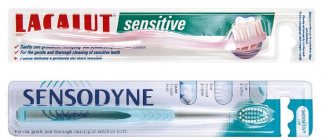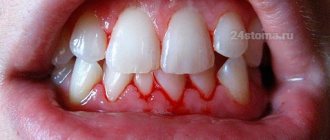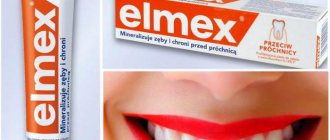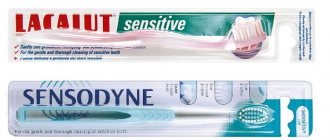Preservatives
Any long-term storage paste contains preservatives that prevent the development of microflora in the product. Please note that sodium benzoate, propylene glycol (PEG, PEG) and propylparaben (generally any parabens) are extremely harmful and are carcinogens (can cause cancer). You should not buy children's toothpastes with such preservatives. Be wary if the shelf life on the package is too long, this is a clear sign of the presence of a high concentration of preservatives.
Why does caries develop in baby teeth?
Caries is a consequence of the proliferation of cariogenic microbes in the mouth. They enter the oral cavity along with the pacifier, through a mother's kiss or a spoon with food when she tests it for temperature. The child’s immunity is weak, and the tooth enamel of baby teeth is still developing, so they are less resistant to external factors, including cariogenic bacteria.
If you don’t take care of your baby’s oral hygiene, germs will actively multiply. They feed on carbohydrates and release harmful acids that corrode the enamel and wash away minerals from it: fluorine, calcium, magnesium, etc. Areas of demineralization are formed, indicating the first stage of carious lesions.
This process can be prevented through caries prevention, part of which is brushing your teeth using a toothbrush and toothpaste. Moreover, special means help stop the progression of the pathology if you start using them at its first stage. Such toothpastes contain various minerals, primarily fluoride and calcium, and are called therapeutic and prophylactic. Many people believe that they are harmful to children. Let's find out if this is really the case.
Anna Mikhnina's blog
Fluoride in children's toothpaste. Yes or no? Is everything so clear?
In recent years, due to the growing popularity of so-called “organic” and environmentally friendly products, I very often come across information on the Internet and in various printed publications that toothpaste for children should not contain fluoride.
The main reason for this statement is the fact that fluoride is poisonous, and children swallow quite large quantities of toothpaste, sometimes deliberately due to its pleasant taste, sometimes accidentally due to the skill of rinsing the mouth not yet formed.
But at the same time, scientific research dating back to the last century has established that fluoride plays an extremely important role in the prevention of caries development. Therefore, in fact, fluoridated toothpastes arose.
If we look at the statistics on the incidence of caries in very young children (1-7 years), we will see that this disease is very widespread in the child population. And in many ways, this is logical, because children are especially greedy for sweets and are not able to control their consumption, their oral hygiene skills are not yet sufficiently developed, and at a younger age they lack even basic motor skills for high-quality teeth cleaning. Therefore, the entire burden of caring for the health of children's teeth lies entirely with the parents during this period. And in particular, the question of choosing hygiene products.
According to an epidemiological dental survey of the Russian population (1999), the prevalence of caries in primary teeth in 6-year-old children was 73%.
The permanent teeth of primary schoolchildren and teenagers suffer no less. An analysis of dental morbidity in children in various regions of Russia, according to an epidemiological survey of the population conducted in 1996-98 in accordance with the order of the Ministry of Health of Russia N 181 dated 05/06/96, showed that 78% of children aged 12 years have caries lesions permanent teeth. By age 15, the average prevalence of caries reaches 88%.
Thus, fluoride is necessary in order to reduce the incidence of dental caries in children. But why do supporters of “organic” toothpastes for children dislike it so much?
Fluoride is poisonous. This is true, but it is aggressive and reactive when it exists in its pure form, in the form of a gas. However, fluorine in its pure form instantly reacts with most chemical elements. Therefore, we will not find fluorine gas in its pure form in nature. Fluorine is most abundant in nature in the mineral fluorite (CaF2), found in soil.[2] In natural water sources, fluorine is contained in the form of the F− ion (up to 95%), followed by the complex magnesium fluoride complex ion (MgF+). Fluorine enters water from the soil when fluorite (CaF2) is dissolved.
Minor concentrations of fluorine compounds are present in the air of some natural zones with volcanic activity, as well as in industrial regions with unfavorable environmental conditions (man-made sources of fluorine).
Fluorine is a vital element for the body. In the human body, fluorine is mainly found in tooth enamel in the composition of fluorapatite - Ca5F(PO4)3 - and in bones.[2]
The toxicity of fluoride compounds to humans depends primarily on their solubility in water, weak alkalis and acids that are present in our body. In addition, the toxicity effect of fluorine compounds is highly dose-dependent, since it is usually achieved through a cumulative effect.
There is a concept of a single toxic (up to lethal) dose of some highly soluble fluorine compounds, but this value is difficult to achieve unless you deliberately take the specified substance by spoonfuls. Thus, the lethal dose of sodium fluoride for an adult weighing 70 kg is 5-10 g.[3]
The toxicity of long-term use of high and moderate doses of fluoride-containing compounds or fluoridated water with hydrated fluoride ions is expressed in the development of the disease fluorosis. I wrote more about this in another article. Is fluorine a terrible poison or a friend of the body?
With long-term use of low doses of fluorine-containing compounds, toxic effects are not observed due to the active absorption of fluoride from the bloodstream by bone tissues; dental fluorosis is rare and is usually due to the genetic characteristics of a particular person (individual characteristics of metabolism and the degree of absorption of calcium, magnesium, strontium).
Absorbed from the blood, fluoride ions are absorbed to the greatest extent by dental tissues, since they are a normal building material for them (the hard layer of enamel consists of calcium and fluorine compounds, with the addition of a certain amount of other elements).
Excess fluoride is eliminated without problems by the kidneys. When the concentration of fluoride that is optimal for a particular person is exceeded, the skeleton is actively involved in the absorption process. Bone tissue constantly exchanges ions of various components of its composition with the blood, thus bones grow and regenerate. When substances that can be absorbed by bone tissue enter the blood in excess, they are absorbed by it in large volumes, which sooner or later can cause harm to the body if the excess intake is not stopped. This also applies to Fluoride. However, its absorption by the skeleton without obvious harm to the body is possible in fairly large quantities. [4]
Toothpaste with fluoride acts topically. When you use fluoride toothpaste or mouthwash, small amounts of fluoride remain on the surface of your teeth and soft tissues as a film of calcium fluoride for a long time after use. It is believed that calcium fluoride helps prevent demineralization of tooth enamel when exposed to acids due to alkalization of the environment with calcium ions. And during periods of pH balance in the mouth, it is a source of calcium ions to supply them to areas of carious lesions. The effectiveness of surface-active fluoride-containing substances for stopping carious processes has been confirmed by clinical studies. [7]
In addition, the preventive effect of fluoride against caries can be traced from studies in various countries that use fluoridation of drinking water.
Fluoride can enter the body of children with water (slightly with food), as well as with ingested fluoride-containing toothpaste.
How much fluoride can a child eat when brushing their teeth?
There are studies that show children swallow between 35% (ages 6-7) and 100% (up to about 2.5 years) of toothpaste when brushing their teeth. At the same time, their body receives about 0.25 mg of fluoride during 2 daily teeth brushings (with a fluoride level in the toothpaste of 1000 ppm). [5]
The development of dental fluorosis in children at the age of eruption of their first permanent teeth was detected in 50% of cases when fluoride entered their body in quantities exceeding 0.0556 mg/kg body weight per day during the first 24 months. life. In 20% of cases, dental fluorosis developed at a fluoride intake level of 0.0376 mg/kg body weight per day in the first 24 months. lives that are critical in the development of this disease. [6]
It can be calculated that with the average weight of a 2-year-old child being about 13 kg, the risk of developing fluorosis occurs with a regular and prolonged intake of about 0.49 mg of fluoride per day into the body.
The amount of fluoride ingested with toothpaste during 2 brushings per day with highly fluoridated toothpaste (1000 ppm) is up to 0.25 mg for children. As the fluoride level in toothpaste decreases (most contain 500ppm), the amount of fluoride you ingest will decrease. In this case twice. Up to a level of 0.17 mg/13 kg = 0.013 mg/kg weight.
With this amount of fluoride, the risk of developing fluorosis in permanent teeth has not been identified (recommended safe and necessary levels of daily fluoride intake for the full formation of enamel for the age group 1-3 years and an average weight of 13 kg range from 0.012 mg/kg to 0.0376 mg/kg body weight child per day).[6]
Problems, of course, are still possible due to, for example, the lower weight of babies aged 1 year and younger. Especially if the child lives in an area with normal or high levels of fluoride in the water.
However, the incidence of caries in both primary teeth and first permanent teeth remains high in Russia for many decades in a row. And preventive measures for children living in regions with fluoride-poor water are especially relevant.
Moscow, and especially St. Petersburg, are regions with insufficient fluoride content in water.[1] Therefore, for children living in these cities, toothpaste with fluoride seems a completely justified solution.
Thus, for residents of St. Petersburg under 3 years of age, toothpaste containing 500 ppm fluoride can be recommended. Or even 1000ppm (for 2-3 year olds) provided that they brush their teeth once a day and have good control over spitting and rinsing of toothpaste.
For schoolchildren and teenagers, toothpaste with fluoride (from 1000 ppm and above) is no longer an option, but a necessity if you want to keep your teeth healthy for as long as possible.
At the same time, it is necessary to correct the diet of children and adolescents living in fluoride-poor areas, using fluoride-containing dietary supplements or fluoridated drinking water, to the level of physiological standards recommended by WHO.
From a personal conversation with my treating dentist, who has more than 25 years of practice, I learned that among her patients there was not a single native of St. Petersburg with dental fluorosis; cases of fluorosis in her practice were quite rare, and these were always out-of-town patients.
I also found out that my attending dentist gave her son a dietary supplement in the form of sodium fluoride every day throughout the entire period of school age. Until the age of 14, her child did not have a single tooth with carious lesions.
This conversation prompted me to make the above thoughts and decisions regarding my own children.
[1] https://mikhnina.com/?p=916
[2] who.int/mediacentre/factsheets/fs318/ru/
[3] SHALINA T.I., VASILYEVA L.S. GENERAL ISSUES OF THE TOXIC EFFECT OF FLUORIDE. — 2009.
[4] Wikipedia. Fluorine.
[5] Fluorine—A current literature review. - p.119. Toxicology Mechanisms and Methods, 2011; 21(2): 103–170
[6] Bhagavatula Naga, VRN Pradeep. "Fluorosis in the early permanent dentition: evaluating gene-environment interactions." MS (Master of Science) thesis, University of Iowa, 2009. -p.82 https://ir.uiowa.edu/etd/28
[7] Fluoride in drinking water. A scientific review of EPA's Standards. — p.42, p.433.
(
1 votes, average: 5.00 out of 5)
Pastes for children from 6 to 12 years old
"LACALUT Teens"
German gel with a pleasant mint-citrus taste. The composition contains sodium fluoride and amino fluoride: the dosage of these components is quite high. The product protects teeth from caries and saturates the enamel, and also allows you to cure caries that is in the so-called “white spot” stage.
A 50-ml tube of paste will cost 120 rubles.
German dentists vouch for the excellent quality of the product.
"ELMEX Junior" (Elmex)
Paste with fluoride, which strengthens enamel and protects against caries. Released. A high dosage of fluoride ensures the elimination of caries in the initial stage of the “white spot”.
The cost of the product is 150 rubles per 75 ml tube.
"PresiDENT Junior" (President Junior)
Italian pasta with a pronounced lime flavor. A product with a good composition, which is slightly worse than the two previous samples. Fluorine is present in compounds that are not the most effective: its dosage is preventive rather than therapeutic (950 ppm).
Contains no sodium lauryl sulfate, sugar or parabens. However, the Italian manufacturer with an impeccable reputation has long established itself exclusively on the positive side, so you don’t have to worry about the quality of the product at all.











